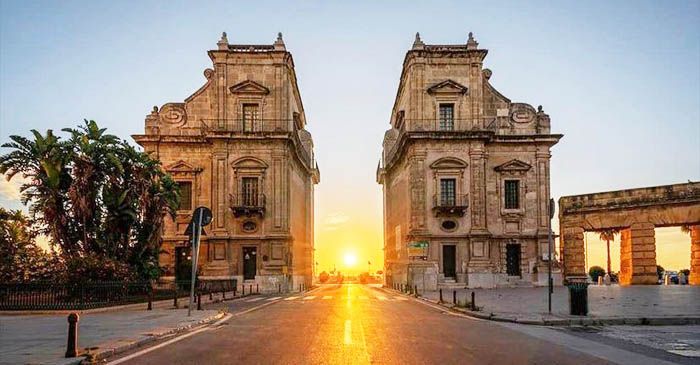The Festino of Saint Rosalia
We are in the heart of the Middle Ages, in a court open to knowledge and refinement.
Here was born Rosalia, the beloved of King Roger and the most beautiful lady among those who graced the royal palace with their charm.
Yet this privileged young woman made a radical choice: she decided not only to abandon the court and refuse a prestigious marriage, but to become a Basilian nun, devoting herself to the poorest and later retreating into a hermit’s life, owning nothing but her simple robe and surviving on what little her refuge could offer.
This choice was not a “withdrawal from the world” — it was a rejection of privilege, to care for the humble, the poor, and those who had nothing, by becoming poor herself.
The Story of Rosalia
The life of Saint Rosalia is told before the Cathedral of Palermo through the language of popular theatre — with projections and light shows illuminating the Cathedral, mobile stages accompanying the seven scenes of her story, and voices and music that trace her journey from birth to the defeat of the plague.
Another theme runs through the performance: women who care, women who dedicate, and women who guard the fragility of our imperfect civilization.
Thus, this is an entirely feminine Festino — from the dancers and actresses performing on stage, to the women who, for the first time, physically carry the Carro (the sacred float).
These women — entrepreneurs, workers, homemakers, and artists — bear the Carro/Nave, symbol of the Church’s eternal movement, through the streets of Palermo, embodying sorrow, hope, and compassion for the least among us.
Saint Rosalia, the Patron Saint of Palermo
According to tradition, Rosalia Sinibaldi belonged to a noble family and was a Palermitan virgin of the 12th century.
She lived at the court of King Roger II before retiring as a hermit on Mount Pellegrino, where she died in solitude.
She later saved Palermo from the plague and became its patron saint, replacing Saint Christina, Saint Olivia, Saint Ninfa, and Saint Agatha.
Legend says that Rosalia appeared in a dream to a hunter, revealing the place where her remains lay.
When the relics were carried in procession through the city, the plague ceased — and the people of Palermo proclaimed her their protector.
The Festino: History and Celebration
An authentic treasure chest of traditions, the Festino di Santa Rosalia attracts tens of thousands of visitors to Palermo every year.
It celebrates the liberation of the city from the plague in 1624, following the discovery of the Saint’s relics on Mount Pellegrino.
The first Festino was organized in 1625 by Cardinal Giannettino Doria, and through the centuries it has renewed itself without losing its charm, devotion, and folklore.
On the night between July 14 and 15, thousands of Palermitans join the grand procession of the Carro della Santuzza, accompanying it from the Cathedral to the Foro Italico.
The traditional historical parade is a captivating mix of religion and folklore, culminating in the spectacular fireworks that light up Foro Umberto I and La Cala with dazzling brilliance.
Culinary Traditions
During the celebrations, Palermo’s popular street food takes center stage: Pasta con le sarde (pasta with sardines), Babbaluci (boiled snails with garlic and parsley), Sfincione (thick Sicilian pizza), Boiled octopus (‘u purpu), Calia e simenza (toasted chickpeas and pumpkin seeds), Boiled corn on the cob (pullanca), Watermelon (‘u muluni).
In Saint Rosalia and her festival, the people of Palermo find a profound sense of shared identity and belonging, beautifully summed up in their timeless cry: “Viva Palermo e Santa Rosalia!”




